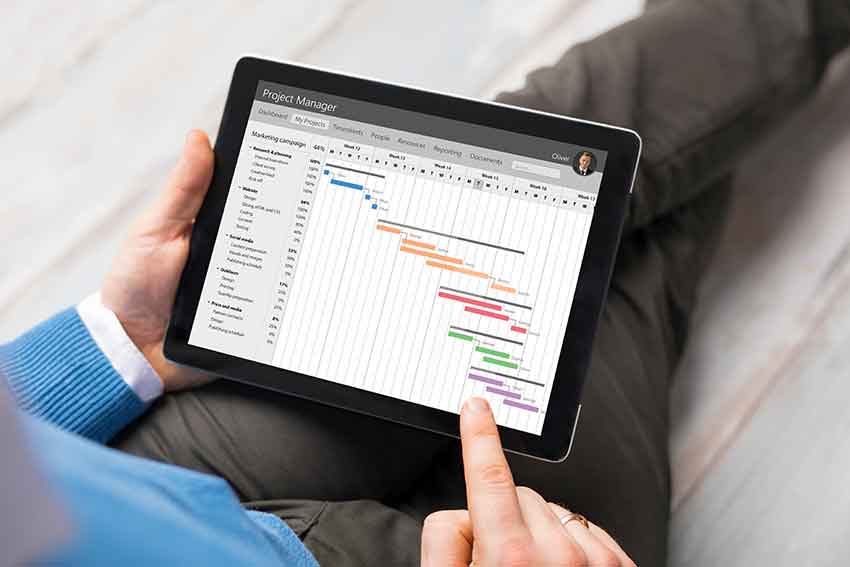Show:
4 Strategies for Better Remote Employee Project Management

Not too long ago, working from an office was considered to be the only way of working, but times have changed and more and more people are choosing to work from home. Remote work has grown 140% since 2005, and that number increased even more due to the COVID-19 pandemic.
There are different types of remote work. Maybe your company has fully remote workers or you may prefer hybrid remote work models, but either way, it’s crucial to have solid project management strategies.
That’s why we’ve compiled this list of strategies you can use to improve project management in a remote environment.
Store data electronically
When you have a remote team of workers, storing data electronically isn’t a choice, it’s more of a necessity. There are multiple different sources remote workers use to exchange and store this data, including:
- Documents such as Word documents and Excel spreadsheets
- Emails and text messages
- Voice and meeting recordings from tools such as Zoom and Google Meet
- Team collaboration tools such as Microsoft Teams and Slack
- Social media accounts
- Server networks
- Computer hard drives
All of this can be classified as electronically stored information, or ESI for short. This term refers to any type of information that is created, used, and stored in digital form and accessible by digital means.

Remote workers are required to store their data electronically, but as a remote worker, you also need to understand all the responsibilities that center around the exchange of ESI. ESI is a legally defined term according to the Federal Rules of Civil Procedure (FRCP) from 2006. It’s also intrinsically linked to the eDiscovery process
Nowadays, companies generate a huge amount of ESI daily and the volume will only keep rising in the coming years. And as ESI is legally defined, it can also be used in legal processes, but for your company’s ESI to be used as such, it needs to abide by the law.
This means you need to follow standards such as BS 10008, which is the British Standard on Evidential Weight and Legal Admissibility of Electronically Stored Information. This standard aims to ensure all organizations can prove their records are trustworthy and can be used as legal evidence if there’s a need to resolve a dispute.
Encourage team morale
One of the disadvantages of remote work is that you need to bring together a group of people who are working from different locations and time zones. This makes it hard to get people from different sides of the world to feel like a collective and work together like a well-oiled machine.
However, you can encourage team morale through a few different activities that will ensure each and every one of your employees feels accepted as part of the collective:
- Recognize achievements. When an employee does something well, recognize their achievements and celebrate them. You can do something simple such as sending a shout-out on your team’s group chat to the employee of the week for example and get everyone to celebrate each other’s successes.
- Encourage friendships. Just because your teammates don’t know each other in person that doesn’t mean they can’t form friendships. Encourage team members to have regular one-on-one communication that can be work-related, or even more personal if they’re comfortable with that.
- Conduct virtual team-bonding exercises. You don’t have to share physical space with someone if you want to conduct team-bonding exercises. Thanks to technology, you can organize book clubs or game nights completely virtually and have fun despite the distance between team members.
- Check-in with employees. You as a project manager are still a part of the team, and you need to check in with your employees regularly and even give them tips to improve their working environment. This way, you can build trust and personal relationships, and make remote work easier for them.
Don’t be afraid to rely on technology
Technology is an essential part of remote working and 44% of businesses are increasing the pace of their digital transformation due to the COVID-19 pandemic. You and your team undoubtedly rely on a plethora of different tools to communicate and collaborate, as well as meet various needs.

While technology can be your best friend, it can also present you with some serious issues if you don’t use it correctly. However, since you have to rely on technology, there are a few tips you should follow:
- Never assume anything. Set clear guidelines with your team and establish a communication plan and tool hierarchy. State which tool should be used for which type of communication and establish the desired frequency of communication to ensure there’s never any confusion.
- Make video conferencing a priority. While you can use other tools such as Slack, a video conferencing tool needs to be your primary tool for internal communication. Video conferencing allows you to check-in visually with your team and it’s the best replacement for in-person communication.
- Monitor all communication tools. Remote teams can run into many communication pitfalls such as missed messages, which is especially common when using multiple communication tools. Make sure to monitor all tools and apps you use to catch any communication issues and handle them promptly.
Hire the right people
A remote project manager requires certain skills and tools to be good at their job, but they also require a remote team that consists of only the best employees. Not everyone is cut out for remote work and just because someone is a good office employee, that doesn’t mean they would be a good remote employee.
As much as 62% of employees expect their employers will allow them to work remotely moving forward, but as a manager, you need to decide if the person you hire is suitable for a job. Telecommuters require certain personal attributes, a great work ethic, and enough technical knowledge.
To ensure you have the right team, you need to work closely with your company’s HR department and present them with a list of qualities you need for employees. They can use this list when screening candidates and rank them based on their competence in the areas you’ve listed.
Your future employees need to:
- Be proactive and be able to get all assignments done without oversight.
- Understand that they need to take steps to avoid feeling isolated while working remotely.
- Accept that over-communication is necessary and don’t see it as a burden.
- Be aware that misinterpretations and miscommunication are unavoidable and that they should always ask for clarification if they don’t understand something.
- Be comfortable with using technology and have enough knowledge of the tools you use in your company.
Final thoughts
Working from home has been present in companies all over the world for years, but the number of remote employees has skyrocketed in the past year. Managers everywhere needed to learn to adapt to a remote work environment and lead a team that doesn’t share an office.
Hiring a remote team of employees can have a lot of benefits and while some people are hesitant to transition to this type of work, there’s nothing to worry about as long as you follow all the strategies you just read about.

 Return to Previous Page
Return to Previous Page








